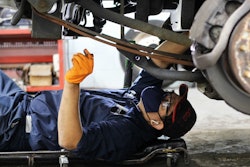One way to help control maintenance costs is for fleets to mitigate the chances of unscheduled roadside maintenance. As reported earlier this month, the American Trucking Associations’ Technology and Maintenance Council found the average distance driven between unscheduled roadside repairs fell nearly 19% in the first quarter of 2021 compared to the fourth quarter of 2020.
Marco Encinas, director of product management for fleet telematics provider Teletrac Navman, said fleets can use their existing telematics systems to help keep unscheduled maintenance in check.
He noted that the rise in unscheduled maintenance had a lot to do with the high freight demand during the pandemic, along with the current ongoing parts shortage.
“The one thing that we did see was a huge increase in vehicles, specifically OTR vehicles, during the COVID pandemic,” Encinas said. “Everybody was home, but the transportation industry was busier than ever. They had to keep trucks running as much as possible. It seems like some of the operators let some of that normal maintenance behavior sort of lax in order to get productivity out of their trucks and keep them on the road.”
 Hear more about how telematics can help you keep on schedule with maintenance on this week's 10-44 webisode in the video above.
Hear more about how telematics can help you keep on schedule with maintenance on this week's 10-44 webisode in the video above.
On a day-to-day basis, Encinas said fleets should make sure their truck drivers are conducting required pre- and post-trip inspections each day, and help drivers better understand what to look for.
“It helps you schedule your maintenance for things that won’t take you off the road immediately, but you definitely have to get addressed sooner rather than later,” he said.
Utilizing tools from telematics service providers can also help drivers, as they allow fleets to customize a checklist of things to go over in addition to their normal inspections.
“When you do those pre-trip and post-trip inspections and actually do the work…that will get you ahead of any kind of maintenance issues and put you in the preventive maintenance mode rather than reactive,” Encinas said. “Then you can selectively take the truck off the road to get stuff done when it’s not necessarily scheduled to be earning any revenue.”
Encinas noted that Teletrac Navman’s system has a maintenance module that allows fleets to schedule routine maintenance for equipment based on miles driven that will alert the driver and maintenance department when the truck needs service.
Another usage case for telematics is keeping track of maintenance costs for each piece of equipment a fleet operates.
“It also helps you keep control of your costs and account for the costs that are going into maintaining your vehicles,” he said. “So, one thing is to do the daily maintenance and preventive maintenance of your vehicles to keep them on the road, but the other piece is now you can start looking at are you putting in more money into these vehicles in yearly maintenance than they’re generating? Maybe it’s time to swap out your truck and get a new one.”
One thing Encinas said Teletrac Navman has been working on, and continues to work on, is incorporating maintenance and productivity data of trucks as they run to determine the best time to schedule them for maintenance.
“There’s things that we’re doing on the telematics side to add more intelligence rather than run static reporting and static alerts, but also put more intelligence into it and help you make better decisions about when to take that truck in and stay ahead of the preventive maintenance.”












